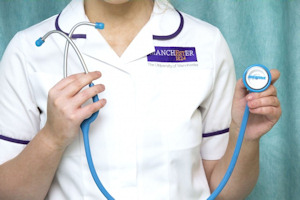Our student nurses receive world first in care-critical frontline digital skills
16 May 2016
New practical digital skills focus at the University sees crucial Patientrack e-observations taught from very first weeks of nursing training, for the first time

Student nurses in Manchester have become the first anywhere in the world to be trained in how to use a vital signs observations technology called Patientrack, before they set foot onto the ward.
The pioneering move at the University signals the start of a changing educational focus to equip the UK’s first generation of ‘paperless’ nurses with real skills needed to help save more lives on the modern wards of NHS hospitals, from the earliest stages of their training.
Manchester’s School of Nursing, Midwifery and Social Work has now become the first school to teach student nurses how to capture important patient vital signs through Patientrack, during the initial weeks of their classroom teaching.
The Patientrack system is making a big difference to patient safety in hospitals across central Manchester, in other parts of the UK, and overseas, where it is helping clinicians to prevent harm and reduce mortality, by ensuring patients at risk of deterioration are identified early and that warning alerts are automatically sent to doctors to ensure prompt interventions. It is also making a significant difference to nursing practice, ensuring accurate observations, reducing burdens placed on nurses and allowing them to dedicate more attention to unwell patients.
Nurses will still be taught how to record bedside observations on traditional paper charts. But 400 students this year have already been taught how to capture patients’ vital signs digitally through Patientrack, on their iPads, from the very beginning of their training.
Carol Wilde, a former A&E matron, now clinical skills tutor at the School of Nursing, Midwifery and Social Work, said: “Learning how to carry out patient observations and recording accurate vital signs is the bread and butter of nursing practice. As the NHS becomes paperless, we need to give students a real feel for the systems they will use.
“Introducing Patientrack into the classroom was the only way to do this, something no other nursing school has done.
“Allowing first year students to learn how to carry out patient observations digitally, through classroom simulation, is an important step in updating nursing teaching in the university environment, so that it reflects the realities of 21st Century NHS nursing.”
In the real hospital environment, Patientrack works by ensuring that important observations are not missed and allows nurses to capture vital signs digitally at the bedside. The software then accurately calculates a patient’s early warning score and automatically calls doctors to intervene when signs of deterioration are present. The system continues to escalate calls until patients receive an appropriate response. This has meant that nurses using the system in many hospitals no longer need to manually phone for doctors to attend, reducing risks and ensuring patients get the response they need to prevent harm.
In the classroom, a student training version of Patientrack has been created, to help students understand how to record patients’ observations on iPads and other tablet devices. Students will even use the technology to help them manage a simulated deteriorating patient for a full day, where they will record observations and experience hospital escalation scenarios in action.
Emily Heggie, one of the first students to use the technology before her initial hospital placement, said: “The early introduction to Patientrack was something I hugely valued once out on placement. I was able to recognise the software and easily find my way to input details when asked. Being able to confidently use the system was a great help.”
Ruth Bayley, who has also just completed her first hospital placement, added: “Training in clinical skills gave me the confidence to use Patientrack on hospital wards. The system has helped me to understand physiological observations better and allowed me to develop my nursing skills when interpreting patients’ health, noticing any signs of deterioration in a patient’s observations faster.”
Professor Steven Pryjmachuk, director of NHS education contracts & external liaison at the School of Nursing, Midwifery and Social Work, said: “Patientrack strengthens our links with practice partners and enhances our students’ understanding of patient safety. Our NHS trust partners use Patientrack, and now our students are able to test out the technology in a safe, simulated clinical setting, in preparation for use in real clinical environments.”
